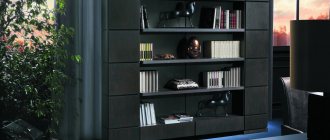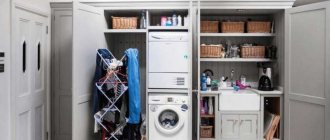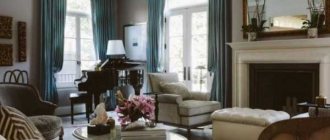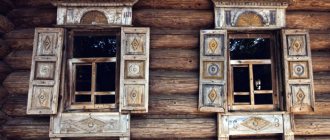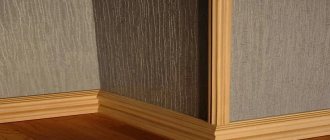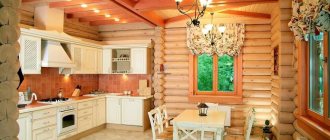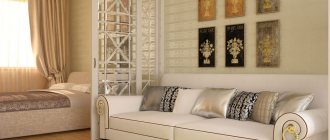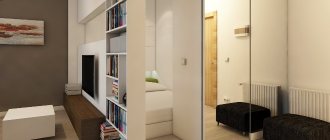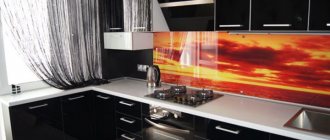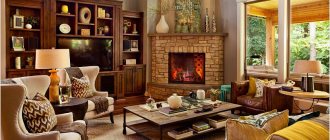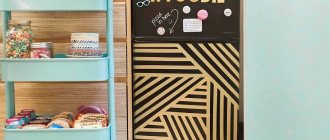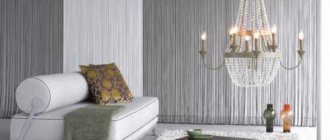Reading will never go out of fashion; many people have a certain number of literary publications purchased or passed down by inheritance. A home library allows you to display a collection of books and serves as a place to relax. Books carefully placed on the shelves decorate the room and allow you to immerse yourself in fascinating stories created by talented writers at any time, while distracting yourself from the bustle of the city. Of course, today most people read books in electronic format. But this can never be compared with the smell of new paper, the pleasant rustling, tactile sensations when turning pages, which creates a special atmosphere in the reading process.
To properly organize the interior of a library, it is necessary to carefully consider the location of the book collection so that paper publications remain safe for a long time and become a remarkable decoration of the room. It is important to provide favorable conditions for this and treat the books themselves with care. For convenience, they can be arranged alphabetically or by genre. Some people sort books by cover color; as a result, bookshelves look beautiful and neat.
Where to place the library
You should not store books in the kitchen or in a dark closet, as they can become damp and spoiled, as in other rooms with high humidity. The best place for a home library would be an office or living room. But it is not necessary to place literary publications in one room; sometimes books are located partially in different rooms, a bedroom, a corridor, a dining room, and so on. This is especially true in Khrushchev apartment buildings with a small area. When there is a shortage of space, many books can be placed on corner shelves, on racks, niches, on the sides, on top of a door or window opening, near or above the fireplace. To do this, you can build structures from plasterboard or purchase suitable functional furniture. It is important to think about the location so that the books are not exposed to direct sunlight. Sometimes the space under the stairs, on the sides or sides of doors, windows, at exhibition stands, above the head of the bed is used. The amount of square meters does not always allow for a separate room for a library, so bookshelves can be distributed among different rooms.
Choosing furniture for your home library
When choosing furniture, you need to focus not only on the number of books, but also on the square footage of the room. To organize the reading space, closed bookcases, racks, shelves, upholstered furniture, desks, in the classic version, are purchased. Ultraviolet radiation and dust have a detrimental effect on paper, so it is advisable to store publications in cabinets with translucent glass doors. Of course, you can also use open shelving, niches or shelves, but then you will have to clean them up more often, neutralizing dust accumulations, which is very inconvenient and takes a lot of extra time. Therefore, this option is more suitable for storing a small number of books.
Modular furniture is very convenient; this makes it possible to independently select the necessary equipment. And built-in furniture designs are a good solution to save space. Modern manufacturers offer a wide variety of different furniture, which allows you to create an original and stylish home library environment. The main thing is that the shelves are suitable for storing books in an optimal vertical position. The reading process itself should be comfortable; for this purpose, soft, comfortable chairs and sofas are purchased. Proper lighting plays an equally important role.
Hillary Rodham Clinton - Children's Library and Learning Center, Little Rock, Arkansas
Reliability and splendor
Architects Polk Stanley Wilcox took an unusual path in creating such buildings, creating the first full-fledged children's educational institution in the state of Arkansas. It includes not only workspaces, but also a kitchen, greenhouse, vegetable garden, and garden that allows children to grow fruits, vegetables, etc., prepare food, and sell produce at the farmers' market.
Safe space for communication
This LEED Gold space is completely safe and teaches survival through smart monitors that track water and electricity usage in real time.
Lighting in the home library
The arrangement must be organized in such a way as to avoid direct sunlight on the book editions; this will prevent the pages from yellowing, which leads to their fragility. Local lighting of sufficient intensity is created in the work area. Floor lamps, lamps, and sconces are used for this. Near the chair you can hang a wall lamp or place a floor lamp on a high leg. For a desk, purchase a table lamp. While reading, the light should fall from the left side, so there will be no shadow that creates inconvenience. Also, books located on the shelves can be illuminated with spotlights or LED strips. This will create a stylish environment, but there is no need to overdo it because for paper publications, exposure to too intense light can be detrimental.
Choose chairs and table
Once you're done with the idea of what color you like, move on to the furniture. After all, no one reads while standing, so decide which chairs will be more suitable.
Before buying a table and chairs, evaluate their size and make sure that they will actually fit in the remaining space. It is important that the chairs and table do not block the lighting.
Classic interior
A home library in a classic style is furnished with wooden furniture with elements of artistic carving, or strict, laconic models with regular, clear forms in a traditional format are selected. You can also add a soft chair with quilted textile upholstery, but preferably made of leather or high-quality leatherette. The classic direction is complemented by parquet flooring or carpet. The finishing touches will be paintings in carved frames, bas-reliefs, antique floor clocks with a pendulum, beautiful vases and exquisite figurines.
More about styles
It is impossible to design a home library correctly without selecting a harmonious style direction. The most suitable styles and their characteristic features are discussed in more detail in the table:
| Style | Character traits |
| Provence | Sensitive, gentle, calm style. Ideal for decorating a women's home library. The color scheme should be light: olive, peach, white, light green. You can use a floral print. It is better to choose aged, rare furniture. |
| Classic | The ideal style for arranging a large, spacious room. Classics are characterized by a restrained design in light colors. The decor of the room should be expensive, the furniture should be wooden. Curtains will play a big role in the design. They should be multi-layered and heavy. |
| Minimalism | Minimalism is an excellent solution for a modern family. This direction is characterized by light colors, simple shelf shapes, a lot of light, and practicality. Decorative details should be almost completely absent. |
A classic interior will require considerable financial investment in wooden furniture
Provence also tends to be natural, but looks simpler and cheaper
Modern cabinet models made of composite materials are quite suitable for minimalist interiors.
See alsoInterior design in mustard color
Modern interior
The modern design of the library uses shelves, racks, and cabinets of non-traditional shapes and colors. This can be a wave structure made of plasterboard or a rack with diamond-shaped sections. You can create an original and compact library office, consisting of an armchair combined with bookshelves and a glass table. In a modern version, it is possible to design a place for books that is in harmony with any stylistic direction, be it modern, high-tech, loft, Scandinavian, English or marine style. At the same time, it is not necessary to purchase newfangled furniture; you can restore the old one and complement it with decor that matches a certain style.
Style decision
The library will fit perfectly into a living room decorated in traditional styles.
Classic design
The interior of the library in a classic style involves the use of massive cabinets and luxurious decorative elements. There should be a designated reading area next to the bookshelves. This is comfortable upholstered furniture and a coffee table. A floor lamp with a beautiful lampshade will complement the interior. The shelves can be either open or hidden behind glass doors.
Classic furniture doesn't have to be expensive.
A shelf section for books, depending on the manufacturer, can be purchased for 9-15 thousand rubles.
Classic design is more suitable for spacious rooms.
English style
The design of the library in the English style is distinguished by the use of natural materials. Natural wood is used: oak, walnut or mahogany. Upholstered furniture has leather upholstery or consists of expensive dense fabrics.
The bookshelves are made from a restrained color scheme, in which terracotta, brown and dark green colors predominate.
Traditional plaid is used in textiles.
The cost of products depends on the materials:
For example, a sofa made of genuine leather will cost from 150 thousand rubles, and the same product made of simple material will cost 30 thousand
Design features in colonial style
A colonial-style library is created from natural materials while preserving the natural texture. The interior is characterized by solidity and restraint. All shades of brown look organic in this design. This style is distinguished not by decoration, but by decorative elements and pieces of furniture. A variety of wicker furniture is used. Its cost varies from 15 thousand to 200 rubles. Various screens are used indoors.
Restoration of old cabinets
Furniture that was made in Soviet times is of very high quality. Many homes have cabinets that have been used for decades and remain intact. True, their appearance does not always fit into modern interiors. But this is not a reason to replace them with new furniture; it is enough to restore them, change the external design, and the result is an exclusive and stylish thing. Doing this is not so difficult and such work is often done at home.
You can change the color of the cabinet in three stages:
- stripping;
- primer;
- painting.
First, the layer of old varnish and paint is erased with sandpaper. Next, if necessary, the existing defects are filled with wood putty. After this, the surface of the cabinet is primed with a special compound. Finally, the furniture is painted in any chosen shades. After painting, the restored cabinet can be left as is, or decorative elements can be added. For example, if you cut out patterns or other details from paper, glue them to the surface with PVA glue and cover them with transparent varnish, you will get designer furniture made using the decoupage technique. For a country style, you can decorate the surface of the cabinet with craquelure technology, painting it with special paints and varnishes to create an antique effect. Sometimes textile lace or wallpaper is glued onto furniture, which looks very unusual and sophisticated. There are many stylistic decorative details available on the market that you can use to create a stylish, modern design for outdated cabinets.
Rules for storing books
In order for paper publications to remain in a safe condition for a long time, it is necessary to adhere to several recommendations:
- Do not store books in rooms with high humidity;
- avoid exposure to direct sunlight;
- Regularly remove dust from bookshelves using a vacuum cleaner or a slightly damp cloth;
- do not place books too close to each other;
- wash your hands before reading.
The optimal temperature for storing books is + 18 degrees with a humidity of 60%. Too low a temperature can lead to the formation of mold or mildew, and too high a temperature can cause books to warp. Pages turn yellow and become brittle from exposure to sunlight. Dust contains harmful microorganisms that have a detrimental effect on paper publications. When you take a book from a shelf, it should give in easily; the bindings will become deformed if placed too tightly. To ensure sufficient ventilation, books must be at least 3 cm from the top edge of the shelf. Even if your hands seem clean, they may still contain microparticles of fat and dirt that are harmful to book pages. Therefore, be sure to wash your hands before reading.
Action plan for creating a rack
1. Glue a decorative strip made of MDF board, 4 cm wide and serving as a frame for the rack, end-to-end on the sides of the shelves. During gluing, do not forget to also check its location using a square so that it is flush while maintaining a right angle.
2. Using a white chipboard board as spacers, mark the position of the shelves in the rack.
3. Using a drill, make the necessary mounting holes, countersink from the outside and connect the shelves using screws.
